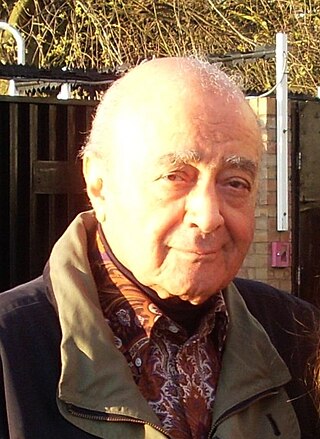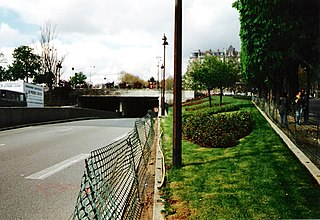Related Research Articles
Inquests in England and Wales are held into sudden or unexplained deaths and also into the circumstances of and discovery of a certain class of valuable artefacts known as "treasure trove". In England and Wales, inquests are the responsibility of a coroner, who operates under the jurisdiction of the Coroners and Justice Act 2009. In some circumstances where an inquest cannot view or hear all the evidence, it may be suspended and a public inquiry held with the consent of the Home Secretary.

Mohamed Al-Fayed was an Egyptian businessman whose residence and chief business interests were in the United Kingdom from the mid-1960s.
A coroner is a government or judicial official who is empowered to conduct or order an inquest into the manner or cause of death, and to investigate or confirm the identity of an unknown person who has been found dead within the coroner's jurisdiction.

Emad El-Din Mohamed Abdel Mena'em Fayed, better known as Dodi Fayed, was an Egyptian film producer and the son of billionaire Mohamed Al-Fayed. He was the romantic partner of Diana, Princess of Wales, when they both died in a car crash in Paris on 31 August 1997.

Paparazzi are independent photographers who take pictures of high-profile people; such as actors, musicians, athletes, politicians, and other celebrities, typically while subjects go about their usual life routines. Paparazzi tend to make a living by selling their photographs to media outlets that focus on tabloid journalism and sensationalism.
Trevor Rees-Jones is a British author and former bodyguard who was badly injured in the car crash in Paris that killed Diana, Princess of Wales, in 1997. Because he suffered a serious head injury, he does not recall any details from the crash.
A licence to kill is a licence granted by a government or government agency to a particular operative or employee to initiate the use of lethal force in the delivery of their objectives. The initiation of lethal force is in contrast to the use of lethal force in self-defence or the protection of life. It is well known as a literary device used in espionage fiction.
In English law, unlawful killing is a verdict that can be returned by an inquest in England and Wales when someone has been killed by one or more unknown persons. The verdict means that the killing was done without lawful excuse and in breach of criminal law. This includes murder, manslaughter, infanticide and causing death by dangerous driving. A verdict of unlawful killing generally leads to a police investigation, with the aim of gathering sufficient evidence to identify, charge and prosecute those responsible.

During the early hours of 31 August 1997, Diana, Princess of Wales, died from injuries sustained earlier that night in a car crash in the Pont de l'Alma tunnel in Paris, France. Diana's partner, Dodi Fayed, and the driver of the Mercedes-Benz W140, Henri Paul, were found dead inside the car. Dodi's bodyguard, Trevor Rees-Jones, was seriously injured, but was the only survivor of the crash.
Barry Albert Mannakee was a police officer with the Royal Protection Squad and bodyguard to Diana, Princess of Wales. Mannakee was transferred from his role as bodyguard for Diana following what was described as an "inappropriate" relationship between the two. Mannakee died in a road traffic accident in 1987, leading to a conspiracy theory that his death was not an accident. An inquest found no evidence of this.
The open verdict is an option open to a coroner's jury at an inquest in the legal system of England and Wales. The verdict means the jury confirms the death is suspicious, but is unable to reach any other verdicts open to them. Mortality studies consider it likely that the majority of open verdicts are recorded in cases of suicide where the intent of the deceased could not be proved, although the verdict is recorded in many other circumstances.
Diana: Last Days of a Princess is a television movie broadcast in the United States by TLC on 12 August 2007 and subsequent dates. It also has aired on Five, UKTV History and UKTV Drama in the United Kingdom, RTÉ in Ireland, ProSieben in Germany, TF1 in France, RTP in Portugal, Channel 7 in Australia, Channel One in Russia, Jim in Finland and the History Channel in India.
An inquest is a judicial inquiry in common law jurisdictions, particularly one held to determine the cause of a person's death. Conducted by a judge, jury, or government official, an inquest may or may not require an autopsy carried out by a coroner or medical examiner. Generally, inquests are conducted only when deaths are sudden or unexplained. An inquest may be called at the behest of a coroner, judge, prosecutor, or, in some jurisdictions, upon a formal request from the public. A coroner's jury may be convened to assist in this type of proceeding. Inquest can also mean such a jury and the result of such an investigation. In general usage, inquest is also used to mean any investigation or inquiry.
Events from the year 2008 in the United Kingdom.
Paul Burrell is a former servant of the British Royal Household and latterly butler to Diana, Princess of Wales.
Alexandra Shân "Tiggy" Pettifer is a British former nanny and companion to Prince William and Prince Harry. She was a personal assistant to Charles III from 1993 to 1999. She has used her married name since her marriage to Charles Pettifer in 1999.

There are many conspiracy theories surrounding the death of Diana, Princess of Wales in 1997. Official investigations in both Britain and France found that Diana died in a manner consistent with media reports following the fatal car crash in Paris. In 1999, a French investigation concluded that Diana died as the result of a crash. The French investigator, Judge Hervé Stephan, concluded that the paparazzi were some distance from the Mercedes S280 when it crashed and were not responsible for manslaughter. After hearing evidence at the British inquest, a jury in 2008 returned a verdict of "unlawful killing" by driver Henri Paul and the paparazzi pursuing the car. The jury's verdict also stated: "In addition, the death of the deceased was caused or contributed to by the fact that the deceased were not wearing a seat belt and by the fact that the Mercedes struck the pillar in the Pont de l'Alma tunnel rather than colliding with something else."
Paul Knapman DL was Her Majesty's coroner for Westminster, from 1980 to 2011. His responsibility for investigating sudden deaths as an independent judicial officer saw him preside over numerous notable cases.
Unlawful Killing is a 2011 British documentary film about the deaths of Diana, Princess of Wales, and Dodi Fayed on 31 August 1997 directed by Keith Allen and financed by Dodi's father Mohamed Al-Fayed at a reported cost of £2.5m. It had a single trade screening during the 2011 Cannes Film Festival.

Innocent Victims is a copper statue of Diana, Princess of Wales, and Dodi Fayed, which was on display at the Harrods department store in London, England, between 2005 and 2018. It was commissioned by Dodi's father Mohamed Al-Fayed when he owned Harrods, and designed by William Mitchell.
References
- ↑ Rayner, Gordon (7 April 2008). "Diana jury blames paparazzi and Henri Paul for her 'unlawful killing'". Daily Telegraph. London. Archived from the original on 3 May 2011. Retrieved 10 December 2022.
- 1 2 "Princess Diana unlawfully killed". BBC. 7 April 2008. Retrieved 2 March 2018.
- ↑ "Met chief will lead Diana probe". BBC. 7 January 2004. Retrieved 10 December 2022.
- ↑ "Chronology – Diana's death and its aftermath". Reuters. 7 April 2008. Archived from the original on 14 June 2016. Retrieved 1 June 2013.
- ↑ "Met boss makes Diana death pledge". BBC. 26 April 2004. Retrieved 29 May 2018.
- ↑ "Police hunt for new Diana clues". BBC. 16 February 2005. Retrieved 29 May 2018.
- ↑ "Diana death a 'tragic accident'". BBC. 14 December 2006. Retrieved 2 March 2018.
- ↑ "At-a-glance: Diana death inquiry". BBC. 14 December 2006. Retrieved 2 March 2018.
- ↑ "Diana Met inquiry cost nears £2m". BBC. 10 August 2005. Retrieved 29 May 2018.
- ↑ "Diana inquiry costs exceed £12m". BBC News. 15 April 2008. Retrieved 5 August 2008.
- ↑ Warren, Jane (18 February 2019). "Cold Case Queen". Daily Express . London. Retrieved 27 March 2022– via PressReader.
- ↑ "Diana police files 'to be shown'". BBC News. 3 April 2007.
- ↑ "Inquests into the deaths of Diana, Princess of Wales and Mr Dodi Al Fayed: Opening statement for a Pre-Inquest Hearing". The National Archives (United Kingdom). 15 May 2007. Archived from the original on 7 June 2009.
- ↑ "Coroner's Inquest into the Deaths of Diana, Princess of Wales and Mr Dodi Al Fayed. Hearing transcripts: 7 April 2008 – Verdict of the jury". The National Archives (United Kingdom). Archived from the original on 7 June 2009.